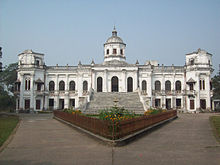
Dhaka Division is an administrative division within Bangladesh. Dhaka serves as the capital city of the Dhaka Division, the Dhaka District and Bangladesh. The division remains a population magnet, covers an area of 20,508.8 km2 with a population in excess of 44 million, It is the most populous country second level division of the world, growing at 1.94% rate since prior count, compared with national average of 1.22%. However, national figures may include data skewing expatriation of male labor force as gender ratio is skewed towards females.
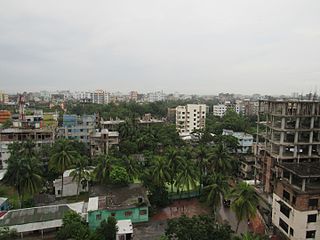
Comilla District, officially known as Cumilla District, is a district located in southeastern Bangladesh. It lies about 100 kilometres south east of Dhaka. Comilla is bordered by Brahmanbaria and Narayanganj districts to the north, Noakhali and Feni districts to the south, Tripura state of India to the east and Munshiganj and Chandpur districts to the west.

Kurigram District is a district of Bangladesh in the Rangpur Division. The district is located in northern Bangladesh along the country's border with India. Under Indian rule, the area was organized as a mahakuma and was not established as a district until 1984.

Mymensingh District is a district in Mymensingh Division, Bangladesh, and is bordered on the north by Meghalaya, a state of India and the Garo Hills, on the south by Gazipur District, on the east by the districts of Netrokona and Kishoreganj, and on the west by the districts of Sherpur, Jamalpur and Tangail. Mymensingh is the 8th administrative divisional headquarter and 12th city corporation of Bangladesh. According to Ministry of Public Administration, Mymensingh is ranked 4th in district status. The density of Mymensingh city is 44,458/km2 which is the second most densely populated city in Bangladesh. Mymensingh attracts 25 percent of health tourists visiting Bangladesh. Once known as the largest district of the Indian subcontinent. Mymensingh town is the district headquarters.

Rangpur (, ; Bengali: রংপুর, romanized: Rongpur, lit. 'City of Colour', is one of the major cities in Bangladesh and Rangpur Division. Rangpur is located in the northwestern part of Bangladesh.

Gaibandha is a district in Northern Bangladesh. It is a part of the Rangpur Division. Gaibandha subdivision was established in 1875. Gaibandha was previously known as Bhabanigonj. The name was changed from Bhabanigonj to Gaibandha in 1875. Gaibandha was established as a district on 15 February 1984. Gaibandha is the administrative headquarters and largest urban centre of this district.

Lalmonirhat is a district, situated at the northern border of Bangladesh. It is a part of the Rangpur Division. Lalmonirhat mahakuma was established as a district on 1 February 1984. It lies north of Kochbihar and Jalpaiguri of West Bengal, south of Rangpur, east of Kurigram and Kochbihar and west of Rangpur and Nilphamari district. The international border line of Lalmonirhat district is 281.6 km long.

Nilphamari district is a district in Northern Bangladesh. It is a part of the Rangpur Division. It is about 400 kilometers to the northwest of the capital Dhaka. It has an area of 1,580.85 square kilometres (610.37 sq mi). Nilphamari is bounded by Rangpur and Lalmonirhat in east, Rangpur and Dinajpur in south, Dinajpur and Panchagarh in west, Cooch Behar of India in north. The many rivers in Nilphamari district include the Tista, Buritista, Isamoti, Jamuneshwari, Dhum, Kumlai, Charalkata, Sorbomongola, Salki, Chikli, Chara and Deonai. There are four Municipal Corporation in Nilphamari district. Area of these Municipalities are Nilphamari 42.70 SqKm(27.50 SqKm Present, 15.20 SqKm Ongoing), Saidpur-34.42 SqKm, Jaldhaka-28.22 SqKm and Domar-9.421 SqKm. There are 60(sixty) Unions, 370 Moujas and 378 Village in Nilphamari district.

Rangpur is a district in Northern Bangladesh. It is a part of the Rangpur Division.

Dhaka (Dacca) is a modern megacity with origins dating to circa the 7th century CE. The history of Dhaka begins with the existence of urbanised settlements that were ruled by the Hindu Gauda Kingdom, Buddhist and Shaivite Pala Empire before passing to the control of the Hindu Sena dynasty in the 10th century CE. After the Sena dynasty, the city was ruled by the Hindu Deva Dynasty.

Mirza Abu Talib, better known as Shaista Khan, was a Moghul General and the Subahdar of Mughal Bengal, he was maternal uncle to the Moghul Emperor Aurangzeb, he acted as a key figure during his reign, Shaista Khan initially governed the Deccan, where he clashed with the Maratha ruler Shivaji, However, he was most notable for his tenure as the governor of Bengal from 1664 to 1688, Under Shaista Khan's authority, the city of Dhaka and Mughal power in the province attained its greatest heights. His achievements include constructions of notable mosques such as the Sat Gambuj Mosque and masterminding the conquest of Chittagong. Shaista Khan was also responsible for sparking the outbreak of the Anglo-Mughal War with the English East India Company.

Dewanganj is an Upazila of Jamalpur District, Mymensingh Division, Bangladesh. It covers an area of 266.59 km2 (102.93 sq mi).

Phulbari is an upazila of Kurigram District in the Division of Rangpur, Bangladesh.
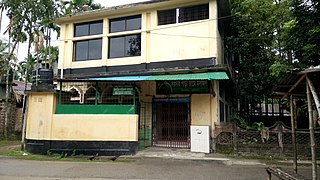
Kurigram Sadar is an upazila of Kurigram District in the Division of Rangpur, Bangladesh.

Ulipur is an upazila of Kurigram District in the Rangpur Division, Bangladesh.
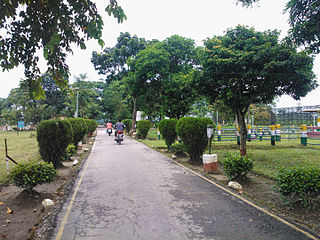
Patgram is an upazila of Lalmonirhat District in Rangpur Division, Bangladesh. It had 27 enclaves, most notably Dahagram–Angarpota which is connected to the Bangladeshi mainland through the Tin Bigha Corridor.
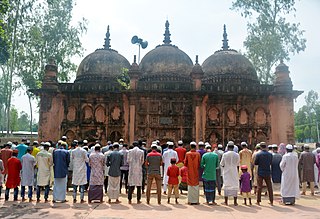
Mithapukur is an upazila of Rangpur District in the division of Rangpur, Bangladesh. The upazila is situated in the middle of Rangpur, surrounded by Rangpur Sadar to the north, Pirganj to the south, Badarganj and Phulbari to the west and Pirgachha and Sundarganj to the east. Mithapukur is famous for being the birthplace of Begum Rokeya and its sweet mango Harivanga.

Rangpur Division is one of the Divisions in Bangladesh. It was formed on 25 January 2010, as Bangladesh's 7th division. Before that, it was under Rajshahi Division. The Rangpur division consists of eight districts. There are 58 Upazilas or subdistricts under these eight districts. Rangpur is the northernmost division of Bangladesh and has a population of 17,610,956 in the 2022 Census.

Kurigram-3 is a constituency represented in the Jatiya Sangsad of Bangladesh since 2024 by Soumendra Prasad Pandey of the Awami League.

The Greater Jessore region predominantly includes the districts of Jessore, Jhenaidah, Narail and Magura in Bangladesh, as well as the Bangaon subdivision of India. Nestled close to the Sundarbans, the region experienced human settlement early on. It served as the capital city of the Samatata realm and passed through several Buddhist and Hindu kingdoms such as the Palas and Senas. Jessore was ruled by Khan Jahan Ali of Khalifatabad, under the Muslim Sultanate of Bengal, who is credited with establishing the Qasbah of Murali and urbanising the region through advancements in transportation and civilization. Jessore later came to be ruled by various chieftains such as Pratapaditya and became familiar to contemporary European travellers as Chandecan before being annexed to the Mughal Empire in the seventeenth century. By 1757, the British East India Company had dominated and started to establish themselves in the region. British rule lasted up until 1947, with Jessore coming under the Provisional Government of Bangladesh from 1971 onwards.


